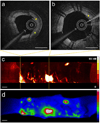Intra-arterial catheter for simultaneous microstructural and molecular imaging in vivo
- PMID: 22057345
- PMCID: PMC3233646
- DOI: 10.1038/nm.2555
Intra-arterial catheter for simultaneous microstructural and molecular imaging in vivo
Abstract
Advancing understanding of human coronary artery disease requires new methods that can be used in patients for studying atherosclerotic plaque microstructure in relation to the molecular mechanisms that underlie its initiation, progression and clinical complications, including myocardial infarction and sudden cardiac death. Here we report a dual-modality intra-arterial catheter for simultaneous microstructural and molecular imaging in vivo using a combination of optical frequency domain imaging (OFDI) and near-infrared fluorescence (NIRF) imaging. By providing simultaneous molecular information in the context of the surrounding tissue microstructure, this new catheter could provide new opportunities for investigating coronary atherosclerosis and stent healing and for identifying high-risk biological and structural coronary arterial plaques in vivo.
Figures




References
-
- Lloyd-Jones D, et al. Heart disease and stroke statistics--2009 update: a report from the American Heart Association Statistics Committee and Stroke Statistics Subcommittee. Circulation. 2009;119:480–486. - PubMed
-
- Choma M, Sarunic M, Yang C, Izatt J. Sensitivity advantage of swept source and Fourier domain optical coherence tomography. Opt Express. 2003;11:2183–2189. - PubMed
-
- Hausler G, Lindner MW. "Coherence Radar" and "Spectral Radar" - New tools for dermatological diagnosis. Journal of Biomedical Optics. 1998;3:21–31. - PubMed
Publication types
MeSH terms
Grants and funding
LinkOut - more resources
Full Text Sources
Other Literature Sources
Molecular Biology Databases

